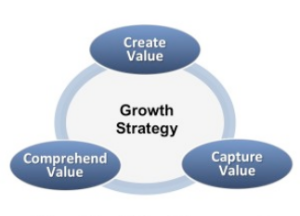
Value creation is highly dynamic, it is going on all the time and can increase, decrease or transform, in different ways, when you exploit your different capitals that will be in constant change and adjusting to reflect your organization’s business activities and eventual outputs.
This is when you can begin to see the value created by the use of deploying all the capitals to build new growth and what I call “stock” that along with “flow”.
Robin Sloan does a brilliant job of explaining this. I loved this explanation of the two:
“There are two kinds of quantities in the world. Stock is a static value: money in the bank, or trees in the forest. Flow is a rate of change: fifteen dollars an hour, or three thousand toothpicks a day. Easy – too easy.”
“Flow is ephemeral. Stock sticks around. Stock is capital. Stock is protein. And the real magic trick is to put them both together. To keep the ball bouncing with your flow—to maintain that open channel of communication—while you work on some kick-ass stock in the background. Sacrifice neither. It’s the hybrid strategy.”
Value is not just from within, it is the links our organizations are constantly making with others, in the interactions, relationships and the combining of the activities. The important need is to manage the stocks and flows of the capitals
The role of all the capitals is crucial to understand, they create or destroy value. It is the constant flow between all the capitals deployed that makes up the value creation process.
Our management within our organizations needs to know where this real value creation resides.
 Understanding all the makeup of capitals needs to be approached in practical ways.
Understanding all the makeup of capitals needs to be approached in practical ways.
The place to focus is on recognizing the material components of what is making up the specific value creation aspects that will provide benefits that have been captured, understood, maintained and then enhanced for the additional value creation
Longer-term value creation
Clearly, the ultimate objective is to enhance the organization’s abilities in the longer-term to appreciate the growth strategy. The more we know as outsiders of the value creation process the more likely this will attract greater investment. Often this is determined by the final product, service or business model outcome.
Today we lack the measures to judge longer-term adequately, that this is enough in organizations. We are judging them on their innovation activity going through the immediate pipeline and that judgment often lacks the real makeup of the application of the different capitals, invested in the knowledge that can provide the sustaining growth- today we are far too geared on immediate expectations and those are locked up in the short-term.
It is becoming critical to understand our sources of knowledge, it gives us the unique capital that differentiates one enterprise from another. The intangibles today are up to 80% of the value assigned to the (market value) worth. Managing these intangibles is critical to our future. Yet, we still have a very poor grasp of how to capture these and drive this knowledge capital. That needs to change.
It is the knowledge that feeds innovation
It is the Knowledge and Innovation combined that make the firm competitive. There is a positive correlation between these two. One amplifies the other, one deepens the other in the connected understanding. The basis for this comes from both human and artificial intelligence.
As we learn to capture from both we build our capital base and strengthen our future potential. We make ourselves more sustainable as well as increasingly adaptive.
The greater the stock of knowledge understanding will increase the potential flows of innovation and this “powers” the future value creation.
Greater engagement or not?
We can leave this knowledge building to the management, just sit back as investors or consumers and simply expect increased dividends and new products. We actually need to dig a little deeper and push management to inform us we will not enjoy any of those nasty surprises when the results fail to materialize.
The argument is that the investors, the stakeholders within a business, need to understand the business logic far more, to make a more informed decision to continue to invest or partner with a particular organization. That logic comes partly from the ability to create value
Knowing the successful generation of all the intangible values and their transformation into tangible forms and how this is systematically being harnessed tends to confirm the realization of the business goals or what the possible risks are.
Gaining better visibility for the process of value creation is necessary.
![]()
Organizations are certainly fairly reluctant to discuss these except behind closed doors to selected investment parties in their investor’s briefings. Making these more visible leads to greater accountability and to be ‘accountable’ you need to understand the makeup of your capitals.
The present incentive for business organizations to become more vocal in explaining their business models, their process for value creation and offering more insight on all their capitals is their need to grow and that comes from investors wanting to invest and customers wanting to buy something that has a sustaining future!
Explaining value creation is essential, it builds the connections.
taken partly from previous value creation work